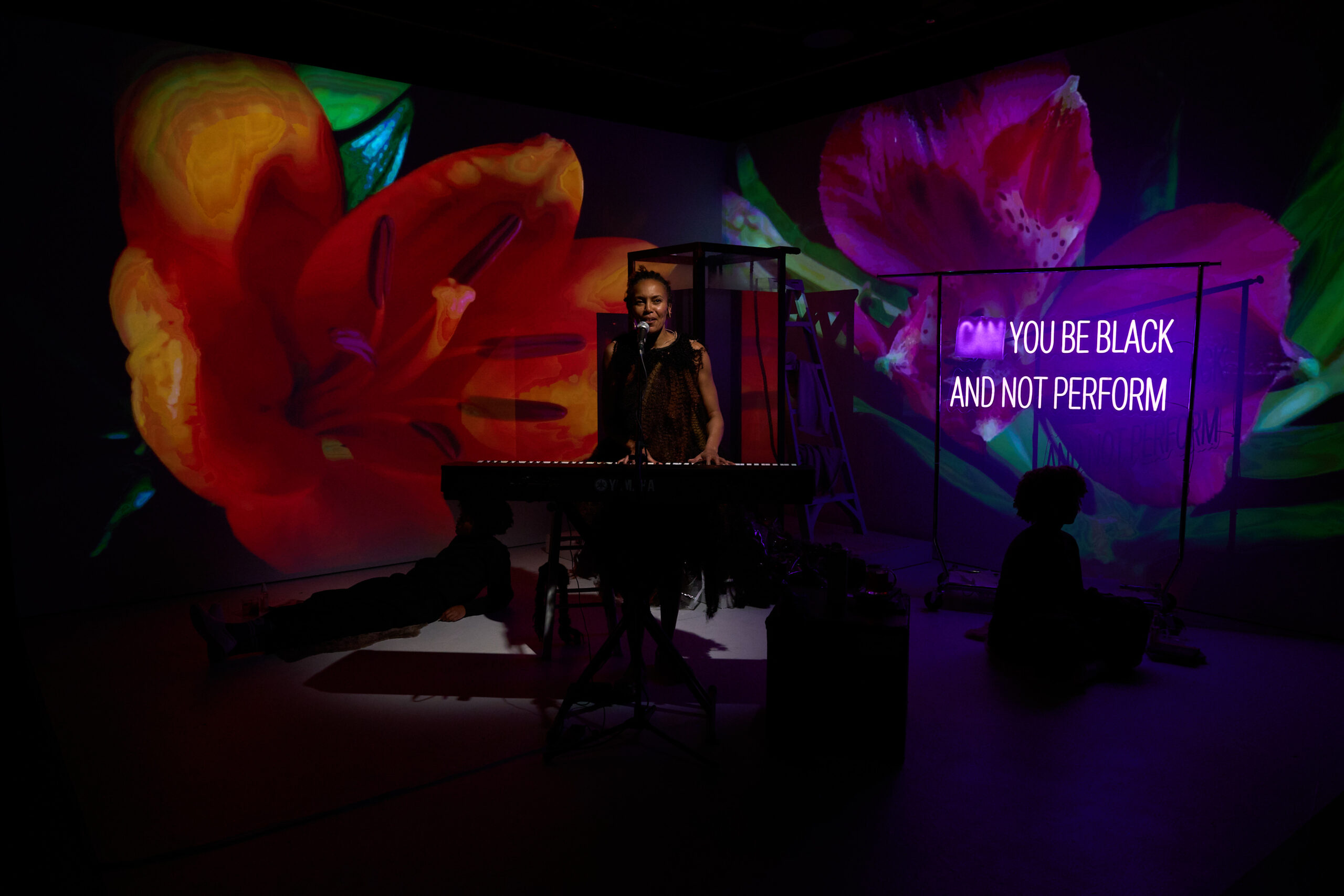
Eisa Davis in The Essentialisn’t. Photo: Daniel J. Vasquez
“This is not a performance,” we will hear several times during The Essentialisn’t, a solo piece that if one were trying not to call it a performance, one might call a number of other things: A living art installation. A concert. A ritual. A ceremony. An incantation. A dialogue. A calling-in and a calling-out.
The experience begins as soon as the audience enters the lobby/cafe of HERE, where projections of Black woman performers appear on a wall and a soundtrack curated by Davis play. Before the theater opens for seating, the audience is invited into a long rectangular room carved out of the mainstage space at HERE, which contains a single installation, in its far corner, lit with the canonizing glow of the traditional art gallery. The installation includes elements to be read, seen, heard, and participated in: A wall text that sets up the encounter: “The artist reckons with how performance as a survival tactic can burden women and Black folx specifically.” Suspended from the grid, a series of books that have informed the conversation, including a collection of Davis’s own plays as well as works by Christina Sharpe, Saidya Hartman, Alexis Pauline Gumbs, and Daniel Alexander Jones–alongside a pair of tap shoes. The sound of water, and the voice of W.E.B. DuBois (Jones again). And a clear plastic ballot box sits on a stool, with a basket of tags on which viewers are invited to write in “essences of Black women” and cast a vote. Already, it’s an event that’s making different demands of its audience than other shows: not “audience participation,” exactly, but audience intellectual engagement.
Once we’re in the performance space (carved out of the mainstage at HERE) , the show begins with a stunning visual metaphor for its central question that lingers throughout the piece. We enter to see Davis, shadowed, perched on a high platform above a glass column, wearing a simple white dress; as the lights come up, we see the column is a tank filled with water.
“Can you be Black and not perform?” Davis asks. And then she lowers herself slowly into water just too deep for her to stand with her head above it. As projections of ocean (by Skye Mahaffie) play behind her and (per the script) a Mende funeral song plays in the soundscape (by Rucyl Mills), Davis treads water in this confined space, suspended by sheer strength, the leverage of her body against the walls of the tank, and the scant support provided by a rope she can twine beneath her feet. It’s perform or sink; perform to survive–but where is the line between existing and performing?
When Davis emerges from the tank, we realize that two piles of fabric and fur on the floor have hidden two other people–the Sovereigns (Jamella Cross and Princess Jacob), who form the rest of the piece’s company: as backup singers, interlocutors, assistants, companions, and sometimes quiet bystanders, sitting on the floor and drinking tea or reading a book.
For 90 minutes, Davis and her chorus spiral through iterations of the central question (displayed in pink neon cleverly suspended on a rolling coat rack), hiding and revealing different sections of the message until it’s pared away to its essence: “black form.” And throughout, the piece sits in a liminal space between visual art and performance (but remember, this is not a performance–though Davis, performing or being, is magnetic): No narrative, not much dialogue. Some storytelling and a lot of singing (the music is by Davis as well, though most of it is more riffs on a theme than constructed songs). There’s a considerable focus on the materiality of the objects that fill the stage, and a constant dialogue with the natural world: water, sand, fur onstage, oceans, flowers, DNA helixes in the projections.
And for a piece that’s incisively and plainly wrangling with a legacy of trauma and slavery, there’s also a lot of simple joy. Davis and her Sovereigns go through the cards in the plexiglas box, sharing the tropes other people have labeled them with, embracing and exorcising as they go.
Toward the end, Davis goes back to the well, as it were, of the opening metaphor, diving back into the tank and submerging herself fully this time, deliberately reclaiming the ground on which we began. It felt like a natural moment to end: a full circle, like the sand circle drawn on the ground several times in the piece. But The Essentialisn’t continues from there, ending instead in a moment of quiet communion among the three women performers. And while this last beat dragged a little for me—perhaps I got too stuck on the idea of the closed circle–I appreciate ending in that acknowledgment of community, and that circle of support among Davis, Cross, and Jacobs.
